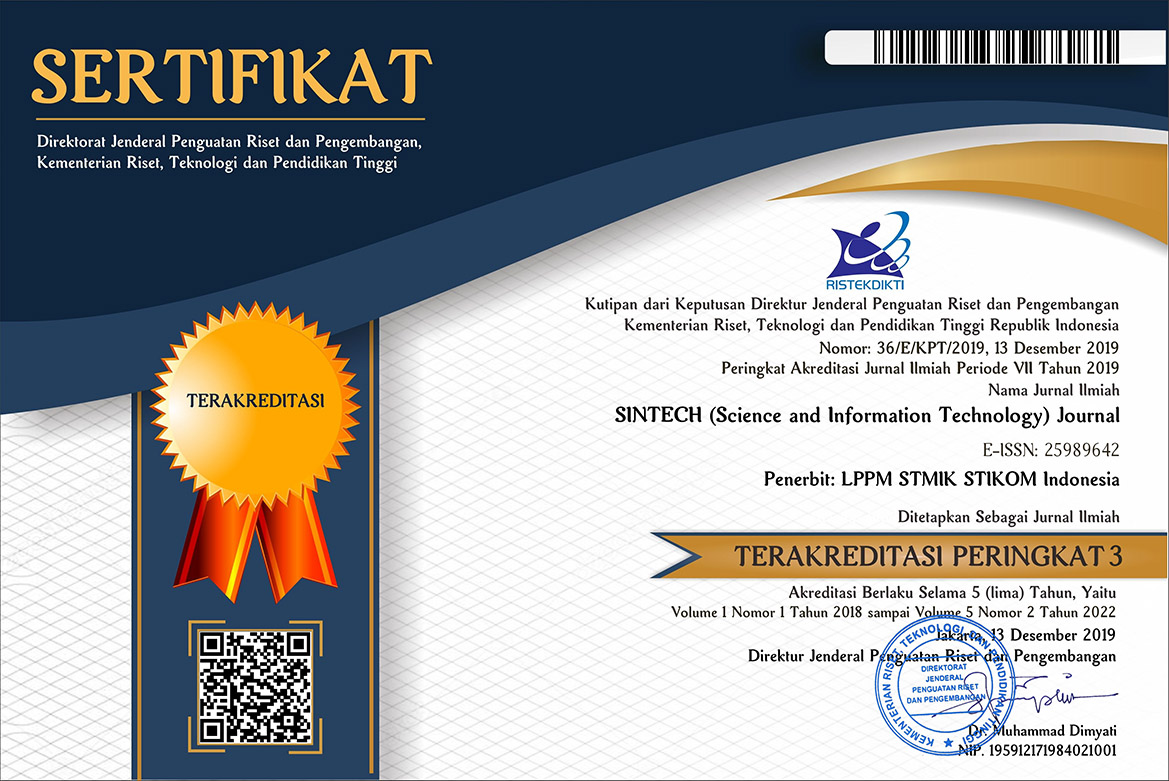PENGGALIAN KARAKTERISTIK PENGGUNA PADA FASE ELISITASI PERANGKAT LUNAK MENGGUNAKAN USER PERSONA
DOI:
https://doi.org/10.31598/sintechjournal.v4i1.572Keywords:
Requirements Elicitation, User Persona, Use Case, PrototypeAbstract
Requirements elicitation is activities aimed at finding the needs of a system through communication with system users. The purpose of requirements elicitation is to find out what problems have been encountered. User persona is a fictional representation of the ideal user. The software developer will begin the design process by conducting user research, establishing communication with the target user and identifying exactly what they need with the product to be made. Personas are generally based on these users and combine the needs, goals, and behavior patterns observed from the target audience. This study aims to determine information systems related to the characteristics and needs of users of the software, so that the data generated in the form of qualitative data from prospective users. By using the hypotheses that are made, which will later be analyzed and used as a basis for developing projects. The results of this study are information in accordance with user needs that will be implemented using a use case and software prototype.
Downloads
References
S. T. Acuña, J. W. Castro, and N. Juristo, “A HCI technique for improving requirements elicitation,” in Information and Software Technology, 2012, doi: 10.1016/j.infsof.2012.07.011.
S. Tiwari, S. S. Rathore, and A. Gupta, “Selecting requirement elicitation techniques for software projects,” in 2012 CSI 6th International Conference on Software Engineering, CONSEG 2012, 2012, doi: 10.1109/CONSEG.2012.6349486.
B. Ferreira, W. Silva, S. D. J. Barbosa, and T. Conte, “Technique for representing requirements using personas: A controlled experiment,” IET Softw., 2018, doi: 10.1049/iet-sen.2017.0313.
L. Schneidewind, S. Horold, C. Mayas, H. Kromker, S. Falke, and T. Pucklitsch, “How personas support requirements engineering,” in 2012 1st International Workshop on Usability and Accessibility Focused Requirements Engineering, UsARE 2012 - Proceedings, 2012, doi: 10.1109/UsARE.2012.6226786.
K. Väänänen-Vainio-Mattila, V. Roto, and M. Hassenzahl, “Towards Practical User Experience Evaluation Methods,” in Proceedings of the International Workshop on Meaningful Measure: Valid Useful User Experience Measurement (VUUM 2008), 2008, doi: citeulike-article-id:8362765.
D. Idoughi, A. Seffah, and C. Kolski, “Adding user experience into the interactive service design loop: A persona-based approach,” Behav. Inf. Technol., 2012, doi: 10.1080/0144929X.2011.563799.
R. L. Gregory, “Perceptions as hypotheses.,” Philos. Trans. R. Soc. Lond. B. Biol. Sci., 1980, doi: 10.1098/rstb.1980.0090.
J. W. Castro, S. T. Acuña, and N. Juristo, “Enriching requirements analysis with the personas technique,” in CEUR Workshop Proceedings, 2008.
T. Bhowmik, N. Niu, A. Mahmoud, and J. Savolainen, “Automated support for combinational creativity in requirements engineering,” in 2014 IEEE 22nd International Requirements Engineering Conference, RE 2014 - Proceedings, 2014, doi: 10.1109/RE.2014.6912266.
S. Bagriyanik and D. Karahoca, “System analyst expectations from requirements engineering tools: A human computer interaction perspective,” Glob. J. Comput. Sci., 2014.
M. Santos, J. Rabelo, R. Barreto, and T. Conte, “Persona security: A technique for supporting the elicitation of security requirements,” in Proceedings of the International Conference on Software Engineering and Knowledge Engineering, SEKE, 2014.
C. Kolski and B. Warin, “From persona to living persona, preliminary data from a pilot study in HCI education,” in Lecture Notes in Computer Science (including subseries Lecture Notes in Artificial Intelligence and Lecture Notes in Bioinformatics), 2018, doi: 10.1007/978-3-319-91743-6_10.
D. Pelawi, “Pembuatan Sistem Informasi dengan Analisis dan Perancangan Berorientasi Objek,” ComTech Comput. Math. Eng. Appl., 2013, doi: 10.21512/comtech.v4i1.2711.
H. Lieberman, “Using prototypical objects to implement shared behavior in object oriented systems,” in Proceedings of the Conference on Object-Oriented Programming Systems, Languages, and Applications, OOPSLA, 1986, doi: 10.1145/28697.28718.
J. Nielsen and T. K. Landauer, “Mathematical model of the finding of usability problems,” in Conference on Human Factors in Computing Systems - Proceedings, 1993, doi: 10.1145/169059.169166.
Downloads
Published
How to Cite
Issue
Section
License
Copyright (c) 2021 Selma Osa Rohimah, Wahyu Andhyka Kusuma Kusuma, Rafiatul Husna

This work is licensed under a Creative Commons Attribution-NonCommercial-ShareAlike 4.0 International License.
Copyright in each article belongs to the author.
- The authors admit that SINTECH Journal as a publisher who published the first time under
 Attribution-NonCommercial-ShareAlike 4.0 International (CC BY-NC-SA 4.0) License.
Attribution-NonCommercial-ShareAlike 4.0 International (CC BY-NC-SA 4.0) License. - Authors can include writing separately, regulate distribution of non-ekskulif of manuscripts that have been published in this journal into another version (eg sent to respository institution author, publication into a book, etc.), by recognizing that the manuscripts have been published for the first time in SINTECH Journal















1.png)




